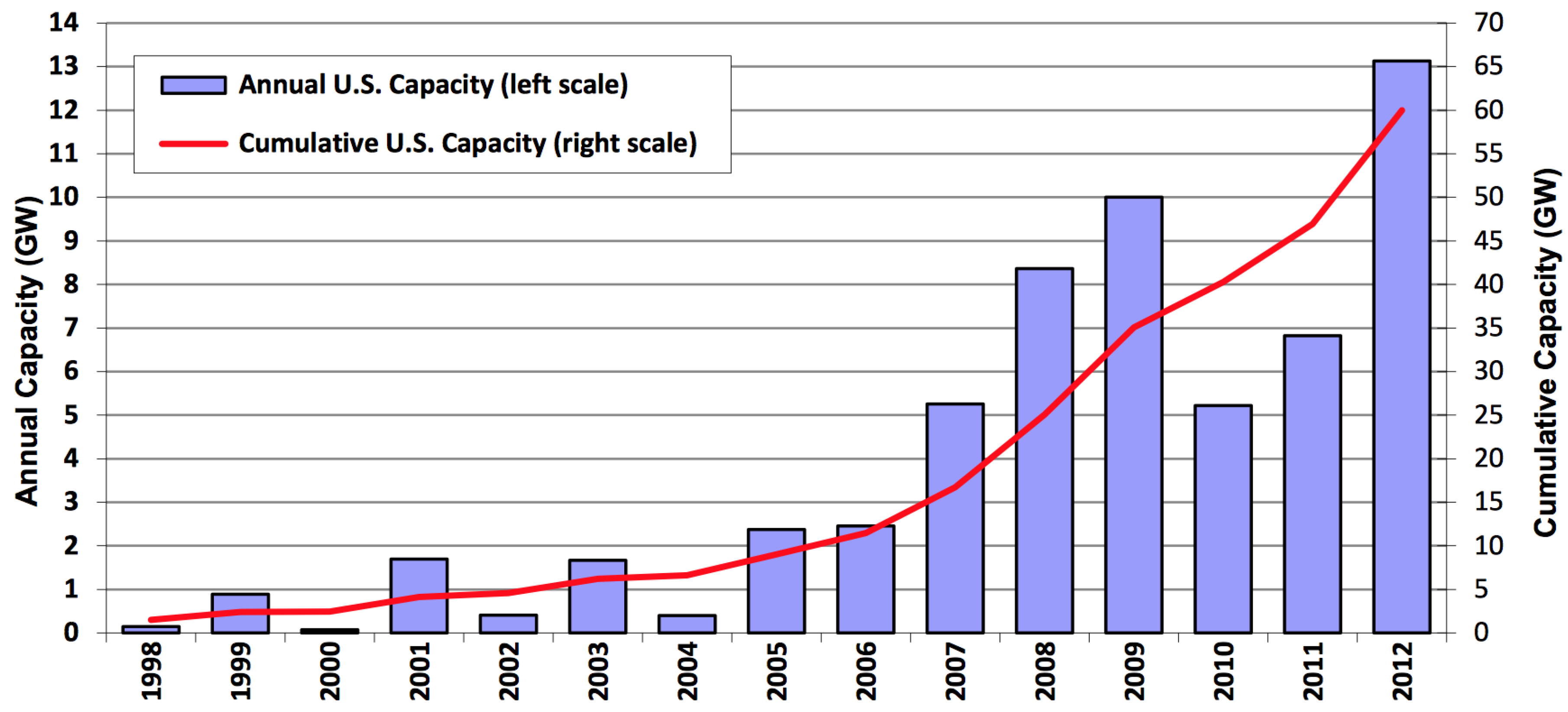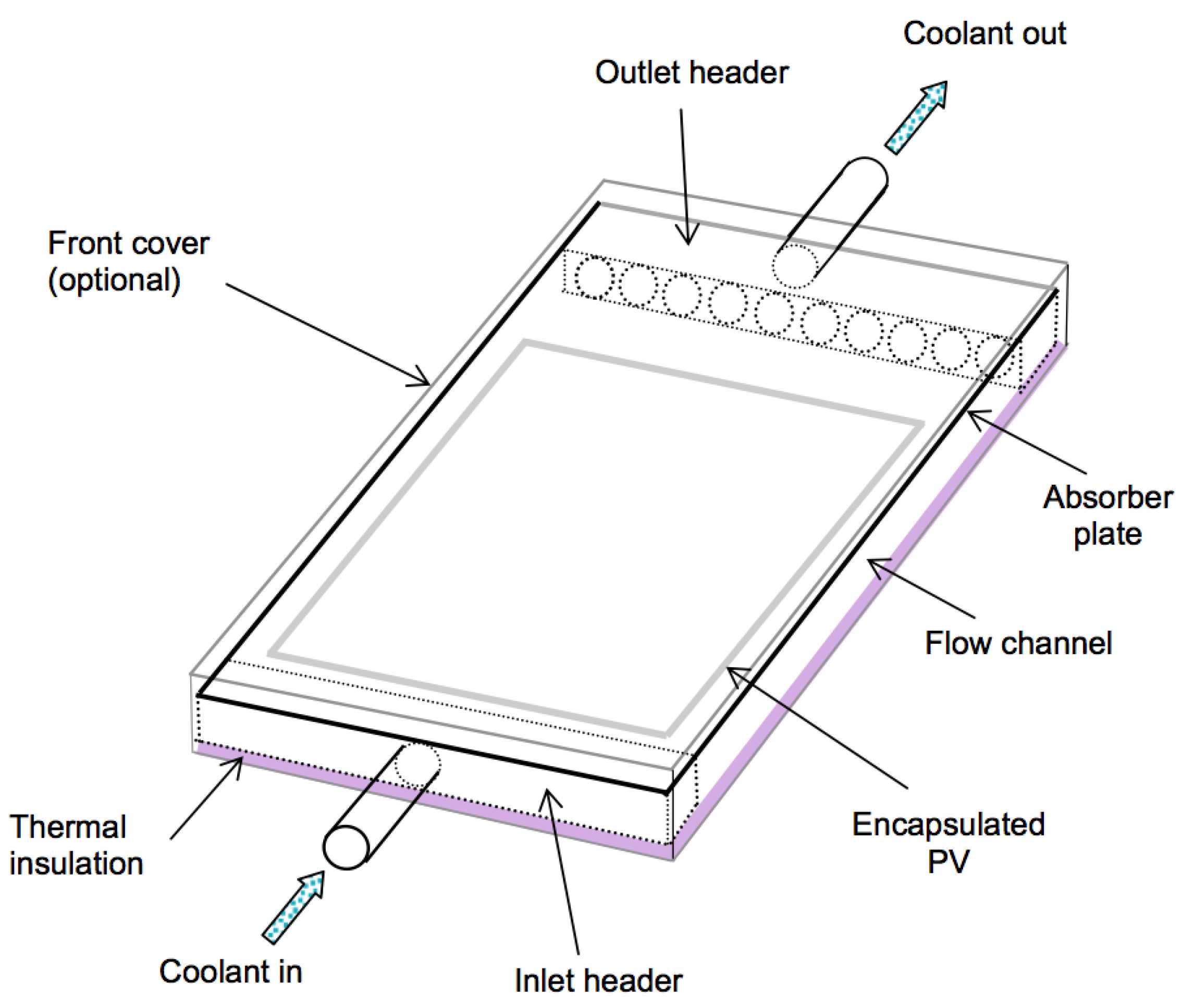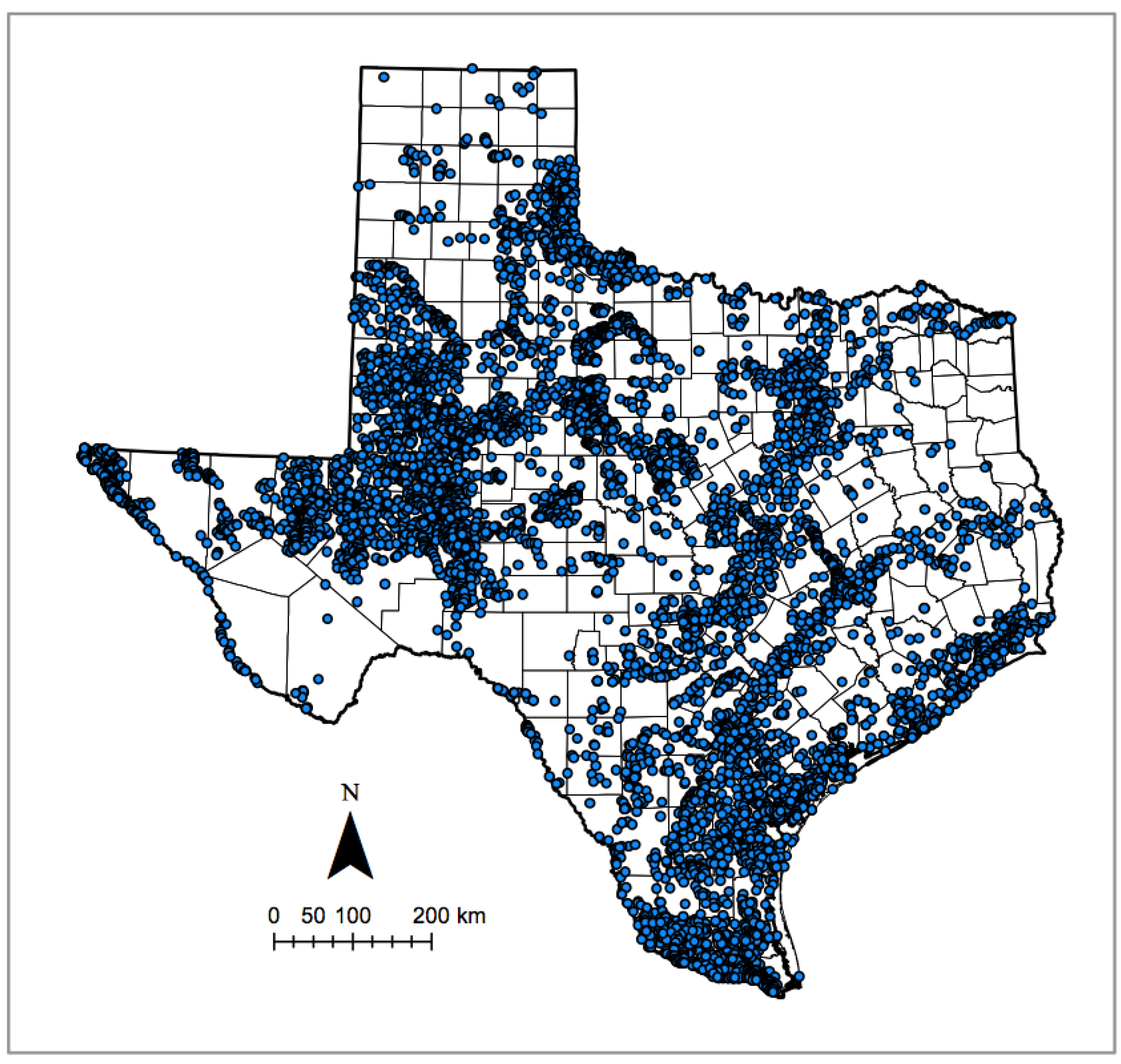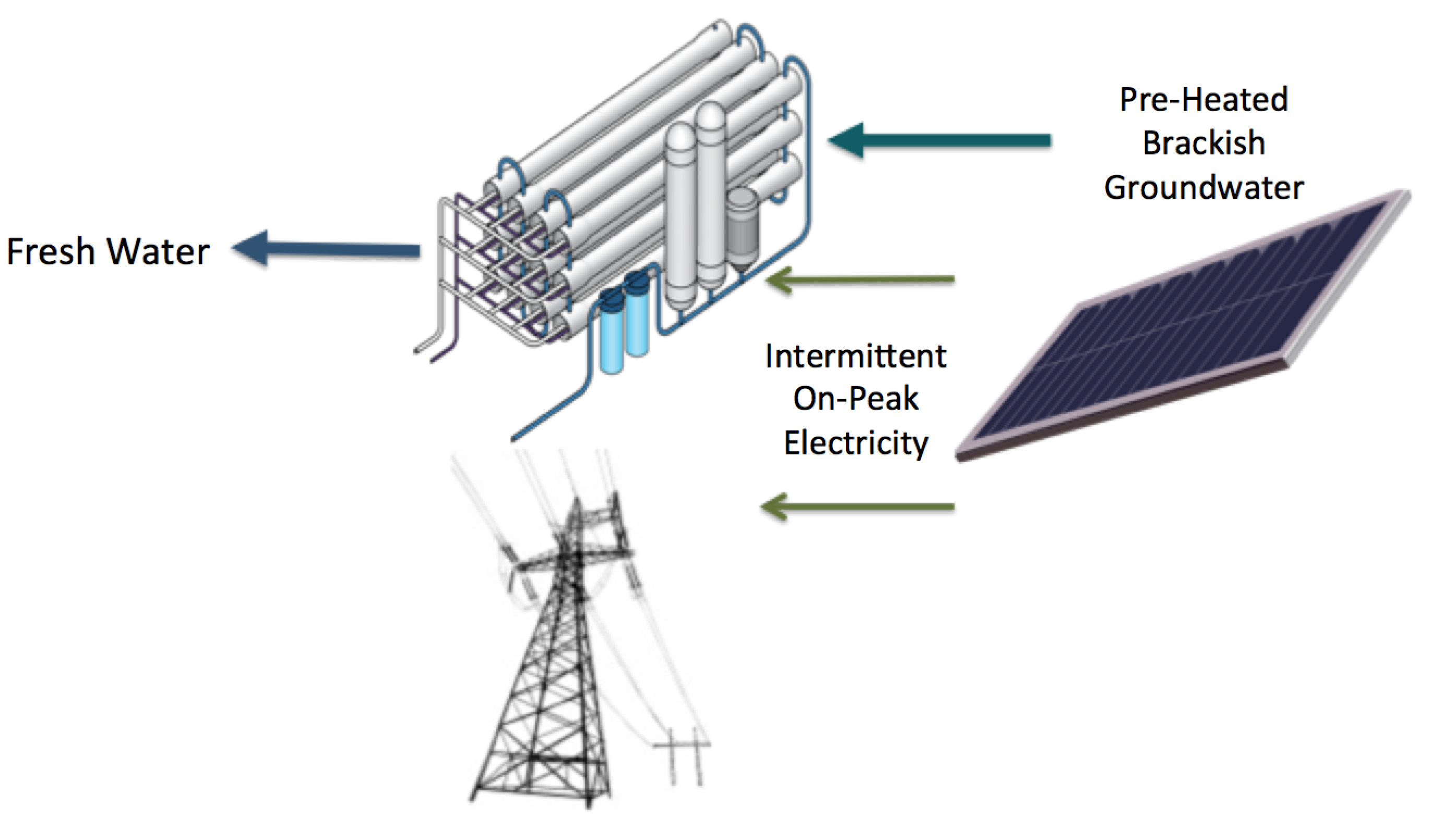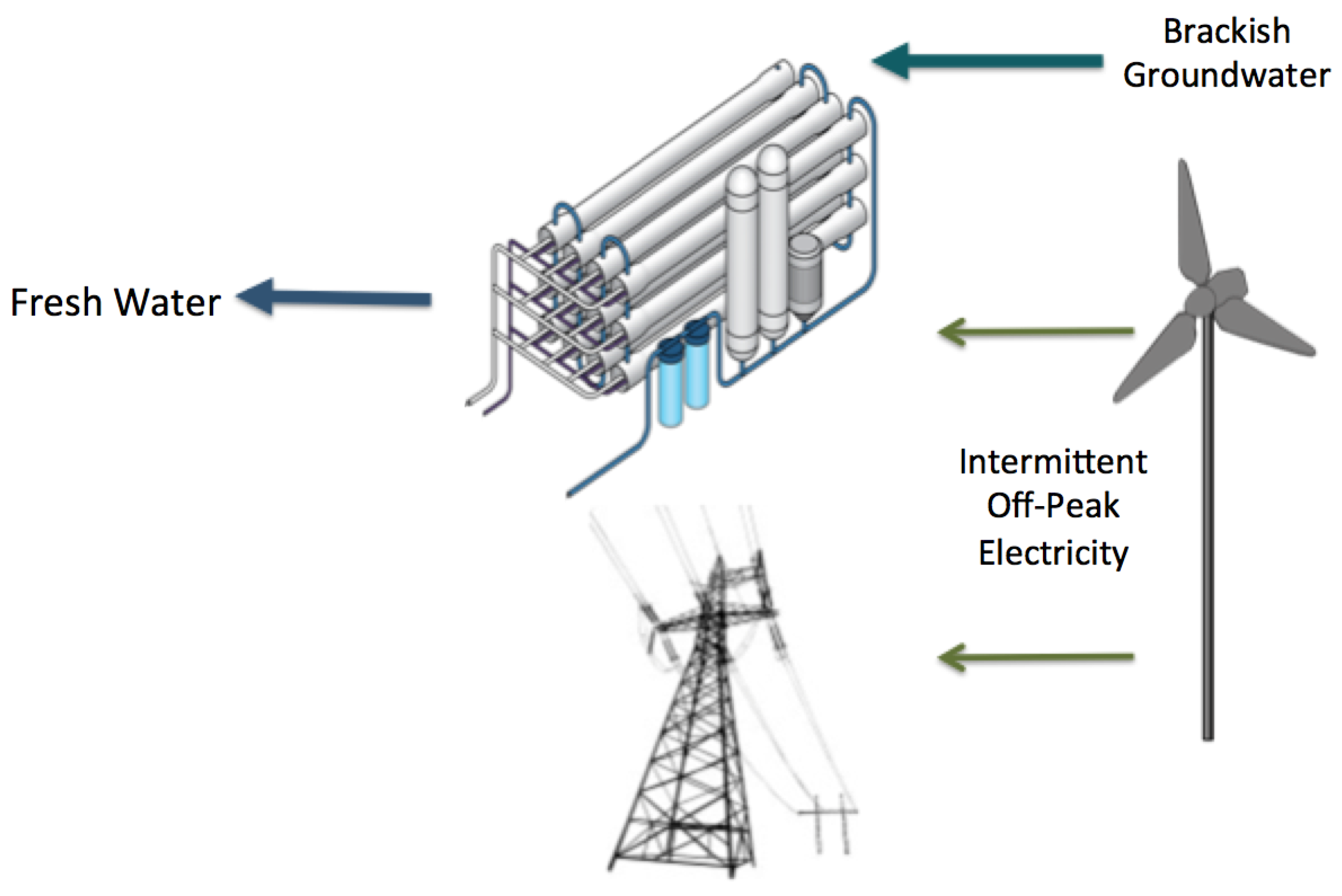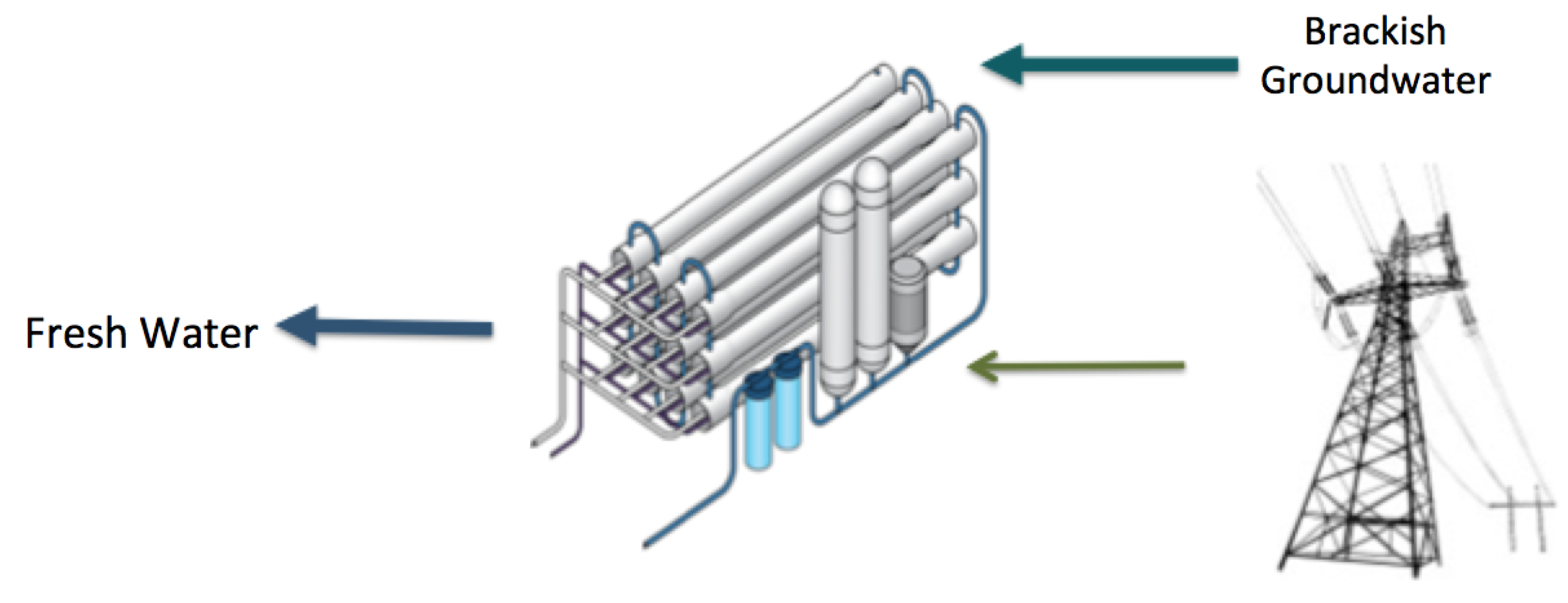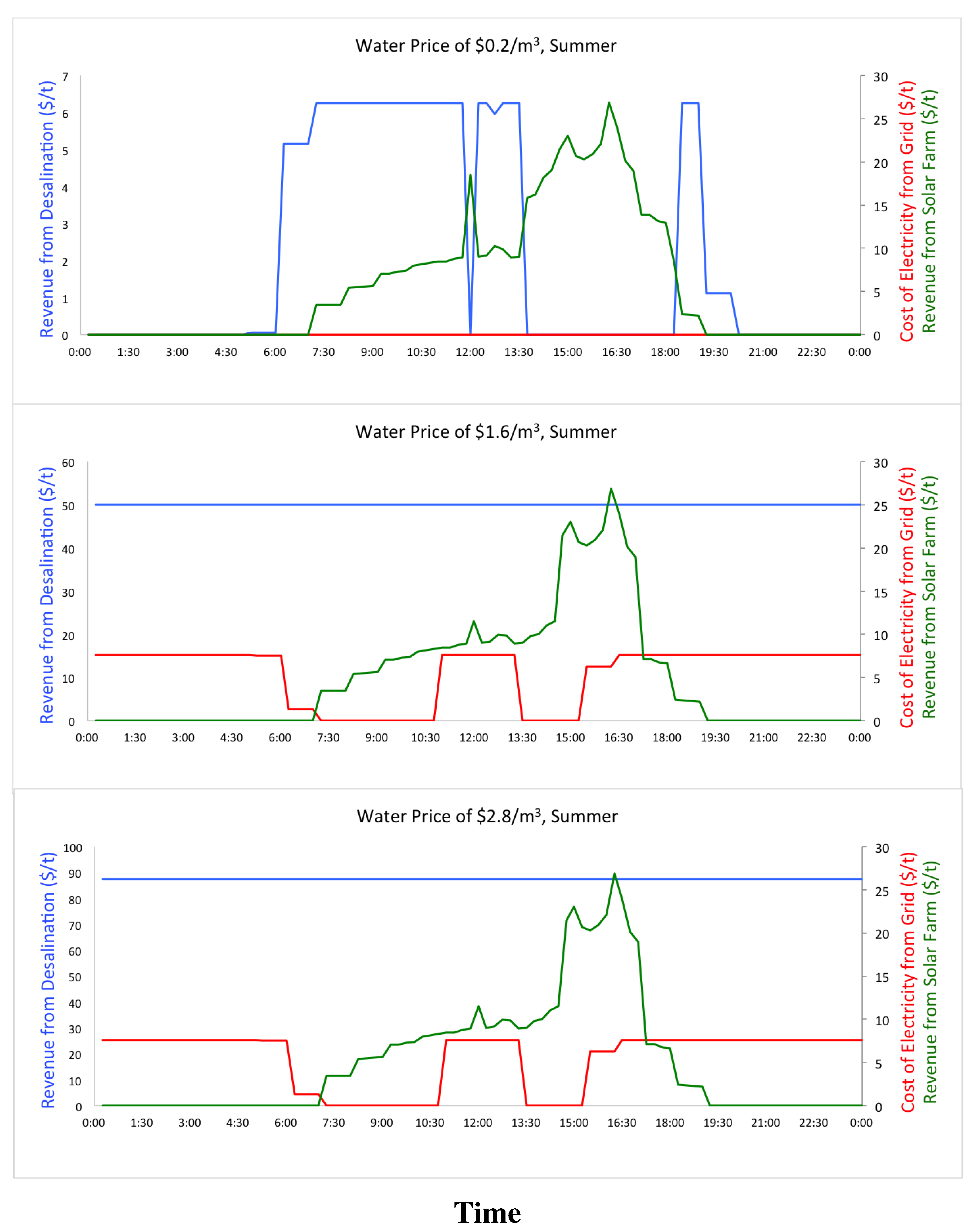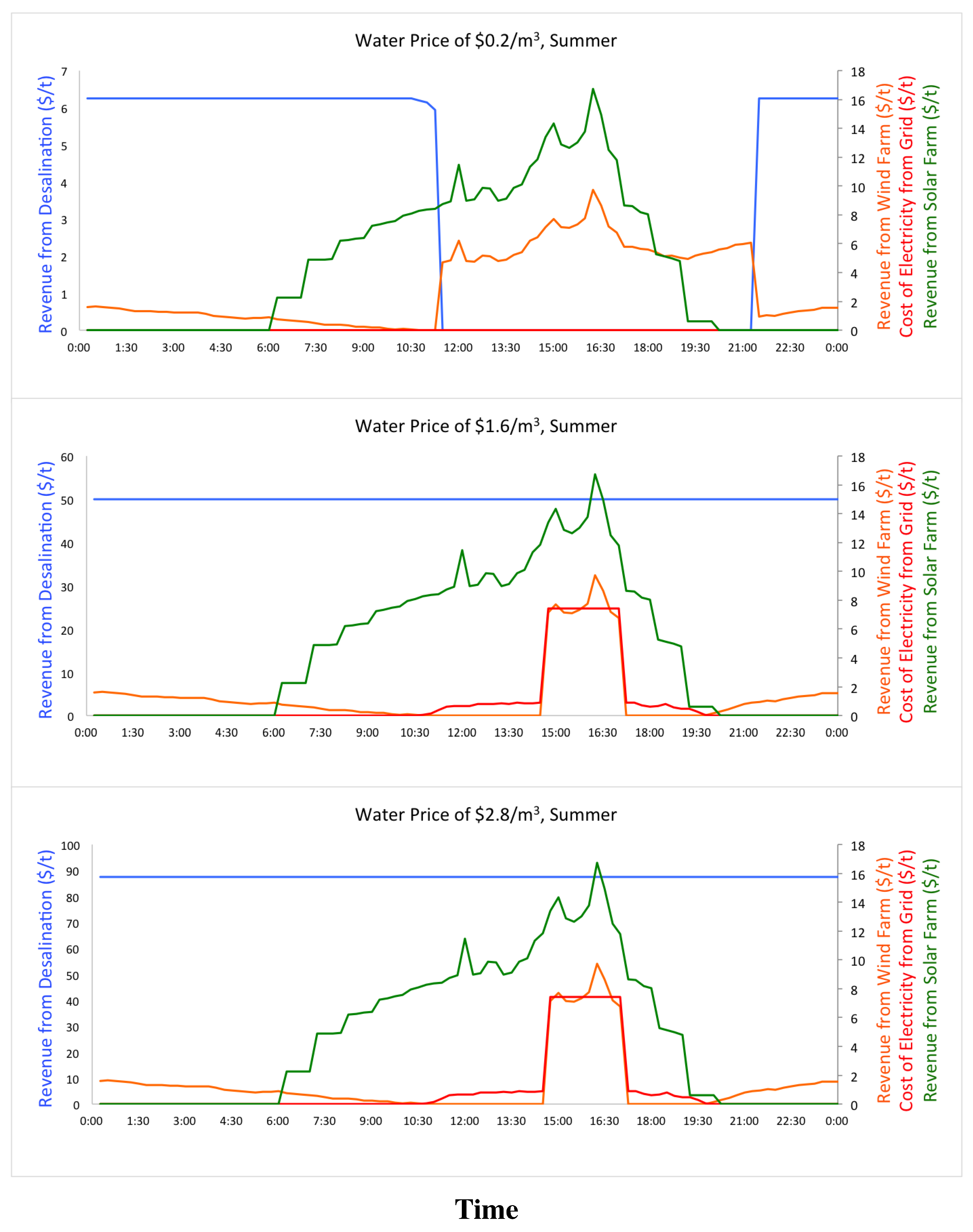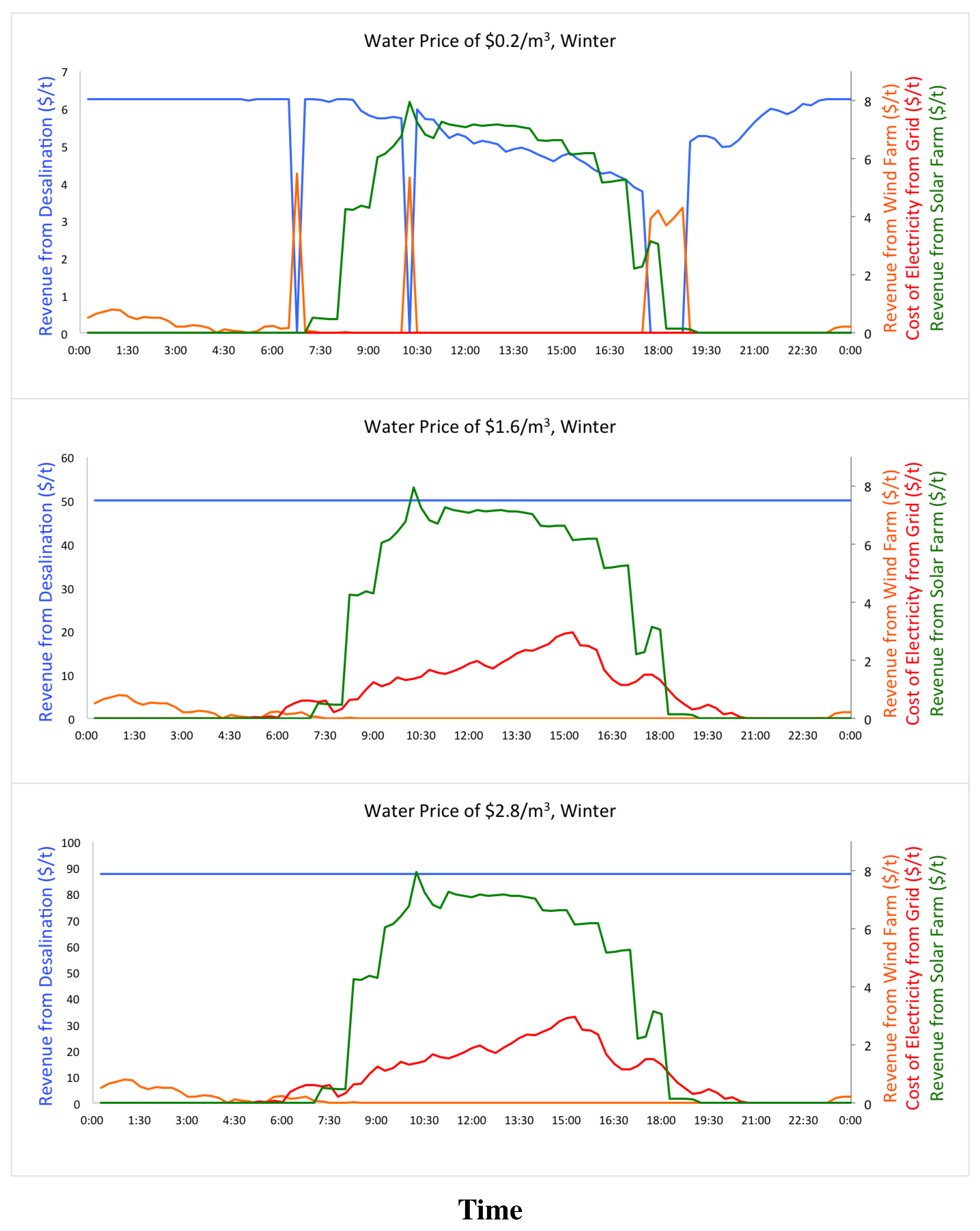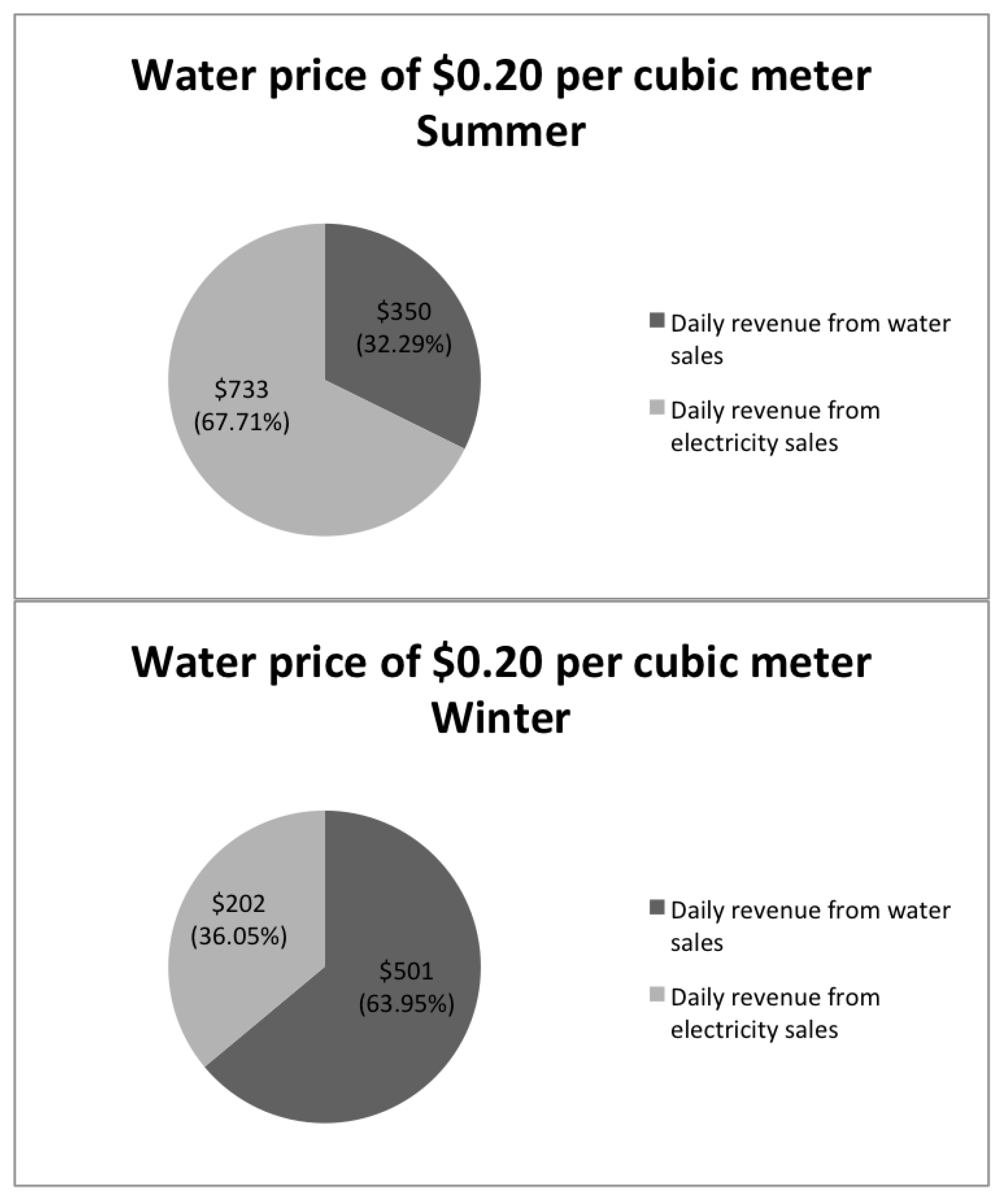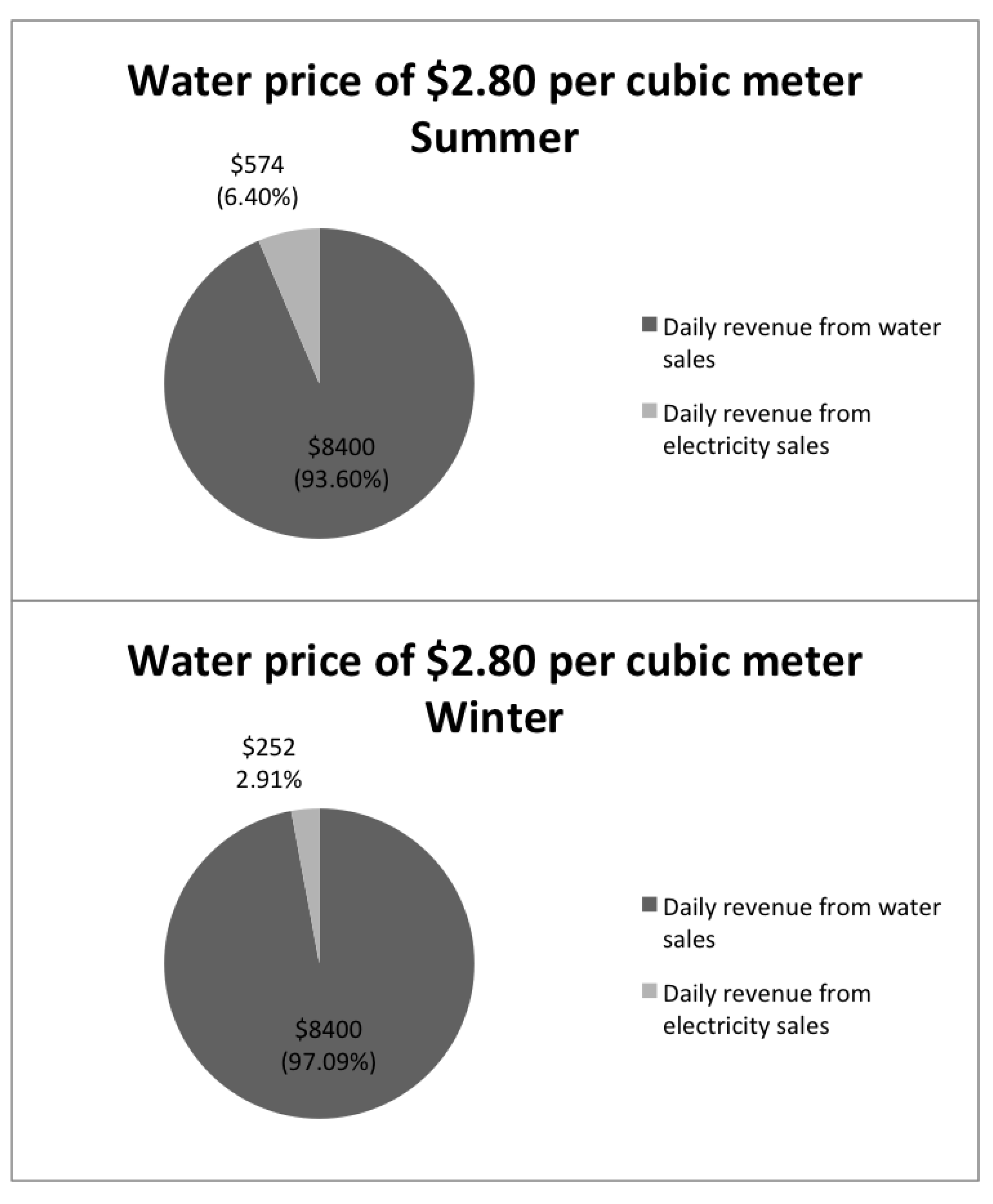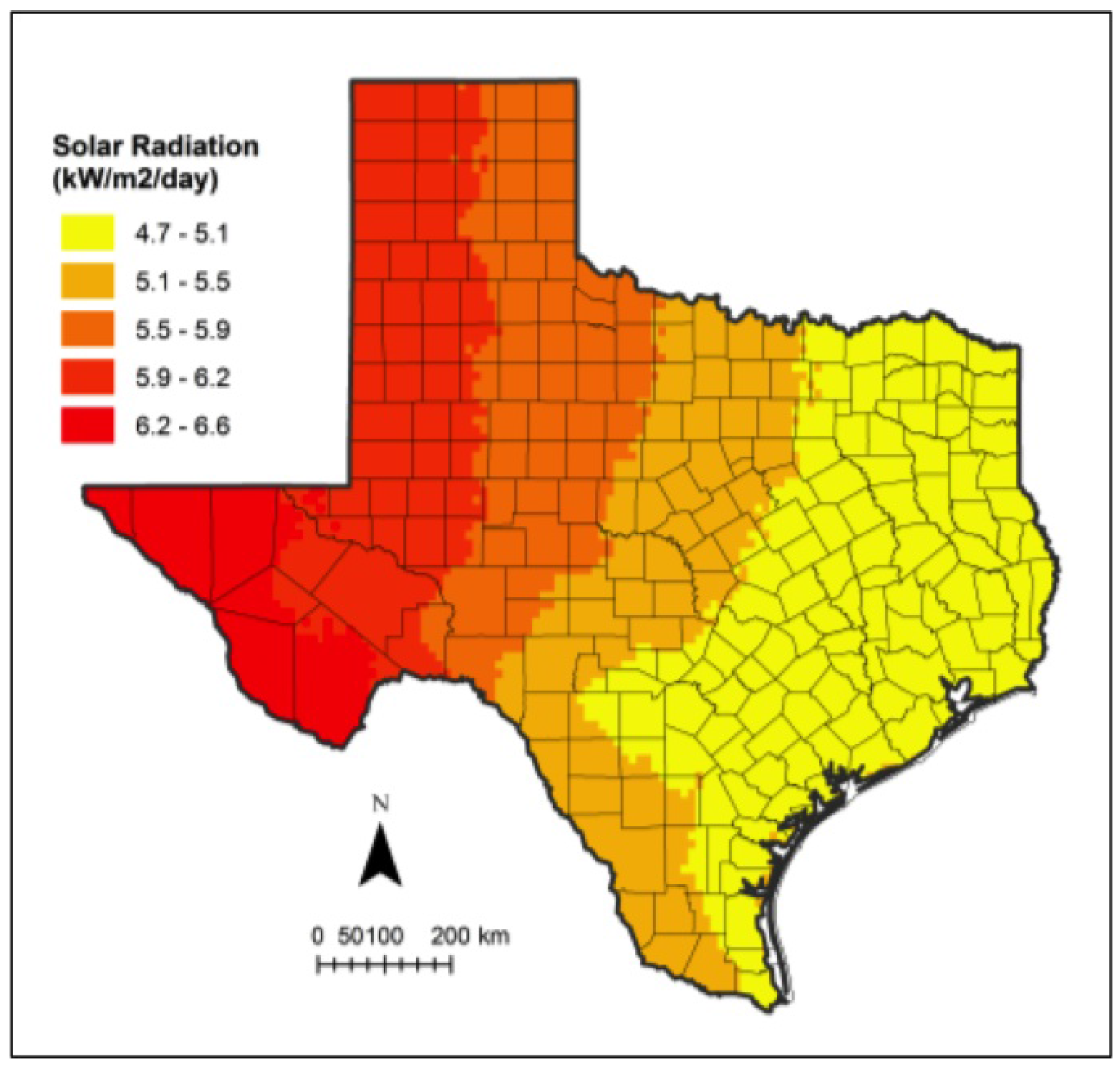2.5.1. Photovoltaic Thermal Solar Technology
In recent years, there have been substantial research developments regarding photovoltaic thermal (PVT) solar technologies as a way to improve the efficiency of harnessing solar energy. These systems are a combination of photovoltaic and thermal solar components that can produce both electricity and heat for useful purposes. Though many collector types have been investigated, air or water is often used a heat collector in these panels [
29].
Figure 3 displays a typical configuration of a flat-plate PVT solar panel. These systems include an enclosed PV model that is cooled by a working fluid entering one end of the panel and leaving through the opposite end. For the analysis discussed in this investigation, brackish groundwater is considered as the PVT module coolant.
Figure 3.
Configuration of a flat-plat photovoltaic thermal (PVT) panel [
29].
Figure 3.
Configuration of a flat-plat photovoltaic thermal (PVT) panel [
29].
Traditional PV panels convert only 5% to 18% of incoming solar insolation into electricity [
30]. A majority of solar energy is converted to heat, raising the temperature of the solar cells. Studies have indicated a significant correlation between the PV module temperature and the efficiency of solar energy conversion into electricity. As the temperature of the PV panel increases, efficiency of energy conversion to electricity declines [
30,
31]. By cooling the solar panels, the efficiency of electricity production can be improved. A PVT solar system, compared to a traditional PV system, can significantly enhance solar power production by limiting the temperature increase of the panels.
Additionally, heat extracted from the solar panels by the coolant can be resourcefully reused. For instance, a European company, Solimpeks, has developed PVT panels cooled by water, in which the hot water leaving the solar panels is used for domestic purposes. The company suggests that its PVT panels are significantly more efficient than typical PV solar systems due to the cooling mechanism. The advertised efficiency of solar energy conversion to electrical power is 25%, more than 50% greater than that of non-cooled PV solar panels [
32]. Although there has been extensive research regarding PVT solar panels over the past decade, applications for heated water using this technology are still very limited [
29].
Studies have been conducted regarding PVT solar modules for desalination using processes other than reverse osmosis. For instance, the use of “waste heat” for Multiple Effect Evaporation (MEE) has been investigated and simulated by researchers in Israel [
33]. MEE systems utilize heat for an evaporation process in which water is separated from solids in a multi-stage system. The process allows for relatively high operating flexibility and short start up time, making it conducive to meeting water demand efficiently [
34]. Researchers suggest that power generation from the combined PVT-desalination process can outperform that of conventional solar farms [
35]. Additionally, under specific circumstances, these studies suggest that PVT-MEE desalination can be cost competitive with conventional desalination [
33].
The investigation discussed in this paper considers a design in which brackish groundwater is used to cool the panels of the modeled solar farm. Research over the past couple of decades has accelerated improvements in PVT systems that have drastically increased the thermal and electrical efficiencies of these modules [
36]. Integrating desalination with solar power offers a potential application for new and exciting PVT technologies. Brackish groundwater can be used in a PVT system to cool solar panels and collect PVT “waste heat”. This configuration is possible because brackish groundwater is typically at a relatively cool temperature compared to the solar panels. By incorporating a design that includes PVT solar modules, the temperature difference between the cool brackish groundwater and the hot solar panels can be used to an engineering advantage to improve the efficiency of solar power production. Using brackish groundwater as a coolant in the PVT system prior to treatment can increase the percent of incoming solar insolation that is converted into electricity. As discussed in the following section, exchanging thermal energy between the brackish groundwater and the solar panels is also advantageous in the water treatment process. Additional implications of heating brackish groundwater prior to desalination should be considered in experimental studies of this technology. However, these additional considerations are beyond the scope of the systems analysis discussed in this paper.
2.5.3. Texas as a Testbed
This study focuses on Texas, although the methodology is applicable to other regions with available resources. As indicated previously, Texas is facing tough circumstances with respect to population growth and depletion of water resources. The 2012 State Water Plan has recommended increasing brackish groundwater desalination as a water management strategy and outlined a number of projects that can provide new water supplies through this process. While desalination may provide a means to meet water supply challenges, the potential increase in energetic requirements to collect and treat brackish groundwater are incongruent with goals to limit the reliance on fossil fuels and reduce carbon emissions. Additionally, municipalities are likely to experience undesirable increases in the cost of water treatment as a result of advancement in desalination activities. Given the State’s plan to install brackish groundwater desalination facilities, it will be prudent for Texas water planners to consider integrating these facilities with renewable power to mitigate unwanted increases in carbon emissions and electricity costs from the grid. Based on plans indicated by water managers across the state, Texas is a time-relevant location to choose for this investigation.
Additionally, the geographic availability of water, wind, and solar resources in Texas, make the state a feasible location for this analysis. Wind speeds adequate for generating power are prevalent in Texas and the state is the nationwide leader in wind power. Over 20% of installed wind capacity in the United States is in Texas, with 12,355 megawatts (MW) of the total 61,108 MW [
38]. The wind power sector in Texas is growing rapidly, and the state installed more wind power capacity (1826 MW) than any other state in the year 2012 [
12]. Additionally, Texas is the lowest cost region for installing wind power projects [
12]. Generally, a wind power classification greater than three is considered to be profitable for generating power from a utility scale wind turbine. As shown in
Figure 4, regions of central Texas and the panhandle have wind classifications above this required threshold [
3]. The availability of wind and the relatively low cost of installation compared to other states make Texas a conducive environment for the development of wind farms as means to meet the growing energy demand.
Figure 4.
Geographic variability of wind classification across Texas [
39].
Figure 4.
Geographic variability of wind classification across Texas [
39].
Texas is also an attractive region for the development of solar power. In a recent assessment of technical potential for PV solar power accounting for the prospective market, economic and technical considerations, and available resources, Texas was rated as the state having the greatest potential for utility-scale solar power [
40]. While solar insolation is strongest in the west and central region of the state, there is technical potential for utility scale solar power throughout much of Texas as a result of available solar resources as well as large and growing populations [
41]. Texas currently ranks seventh in the United States in total installed solar capacity with 134 MW and ninth lowest in the Nation for installed cost at $5.83 per Watt [
42]. Solar energy potential increases from east to west across the state, as shown in
Figure 5, which displays the annual average solar insolation. Across the state, solar insolation ranges from 2 to 7.2 kilowatt hours (kWh) per square meter per day [
43]. This range of solar insolation, in addition to growing energy demand in the state, makes Texas an ideal region for utility-scale PV solar installations.
Figure 5.
Annual average solar insolation in Texas [
43,
44].
Figure 5.
Annual average solar insolation in Texas [
43,
44].
The abundance of brackish groundwater throughout the State is another key reason Texas is a conducive location for this analysis. As shown in
Figure 6, there are over 10,000 current wells reaching groundwater considered “brackish” (TDS between 1000 and 10,000 mg/L) [
45]. There is an estimated 2.7 billion acre-feet of brackish groundwater in the Texas [
4]. The strategies outlined by water planners and availability of brackish groundwater make Texas a suitable region to study in this analysis.
Given the availability of these resources around the state, Texas offers an appropriate location to study the integration of brackish groundwater desalination with wind and solar power. Developing a model with Texas as a testbed enables this analysis to provide a methodology that will also be applicable to other regions with similar solar, wind, and water resources.
Figure 6.
Brackish groundwater wells in Texas [
45].
Figure 6.
Brackish groundwater wells in Texas [
45].
This investigation offers an analysis of desalination powered by renewable energy sources. By developing a water treatment model based on fluid dynamics, an energy model based on thermodynamics, and an optimization model that integrates the water treatment and energy models, this investigation provides insight into the potential for powering desalination with renewable energy. Consideration is given toward the economics of wind and solar powered desalination in the optimization model. This model develops a daily schedule for desalination based on electricity prices and availability of renewable power. Additionally, the optimization model develops results and a methodology to determine expected revenue from water production, electricity sales to the grid, as well as the cost of electricity purchased from the grid for a desalination facility integrated with wind and solar power. By modeling a desalination plant coupled with wind and solar power and considering the economics of this idea, the hope of this analysis is to gain a practical understanding of the benefits and tradeoffs involved in water treatment powered by renewable energy.
Additionally, the analysis performed here offers a novel approach to blueinvestigate the energy-water nexus in the realm of water treatment and renewable power. As discussed in the previous sections, earlier models have analyzed solar-powered desalination, wind-powered desalination, and solar/wind-powered desalination. However, few models have analyzed the possibility of solar and/or wind powered desalination in which the facility is also integrated with an electricity grid, in this case with the Electric Reliability Council of Texas (ERCOT) grid. Moreover, with the exception Clayton’s analysis of wind-powered desalination [
3], there have not been investigations to model an integrated facility in which power can not only be bought from the grid, but also sold to the grid from the modeled wind or solar farm. There are potentially times of day when electricity prices are high enough that an integrated facility would prefer to sell wind or solar-generated electricity to the grid rather than use the electricity for desalination. An economic analysis of a modeled wind/solar powered desalination facility can provide insight into the expected operational schedule of such a facility. The analysis in this investigation builds and uses an optimization model to determine times of day when it is economically beneficial to make one of three decisions: use wind or solar power for desalination, sell wind or solar power to the grid and buy electricity from the grid to power desalination, or halt the desalination process. In addition, the analysis develops a model to estimate daily revenues from desalinated water sales and wind/solar power production as well as the expected cost of electricity from the grid. By analyzing grid-connect wind and solar-powered desalination, this investigation fills a knowledge gap regarding how an integrated wind/solar-powered desalination facility can interact with the electricity grid to provide both desalinated water and renewable power.
Furthermore, this investigation includes analysis of a PVT solar configuration in which water is used to cool solar panels while thermal energy from solar panels is used to preheat feed water. As discussed in previously, a PVT solar module can be used as a sort of heat exchanger between the solar panels and brackish groundwater. Transferring heat from the solar panels to the water is mutually beneficial for solar power production and water treatment: cooler solar panels are more efficient at converting solar insolation into electricity while preheated water requires less energy in the desalination process. By considering the possibility of using PVT solar panels as part of a desalination plant, this investigation attempts to fill the void in offering a new and potentially beneficial use for PVT panels. This investigation hopes to answer questions regarding how a PVT solar configuration may perform compared to other configurations in a modeled desalination plant and offer insight into the potential for use of PVT solar panels at a desalination facility.
Another novel aspect of this this investigation is to investigate the potential to diversify revenue in a desalination facility combined with renewable power. It is possible that providing wind and solar power at a desalination facility can mitigate risks associated with declining water sales by providing revenue from electricity. Similarly, the facility may also reduce the risk of declining electricity sales by selling water. A desalination facility integrated with renewable power brings in revenue from two different markets, water and energy, incorporating diversity in revenue.
